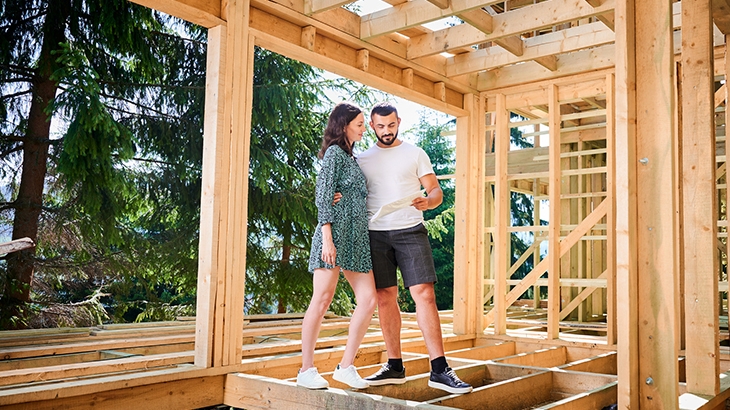7 Tips for Buying Land to Build a House
Ah, the appeal of the custom-built house. For many, it's an American dream. Finding a piece of land all your own, working with a builder (or your own two hands!) to build something specifically designed for your family, and being the first ones to call it home. Unfortunately, as with many multi-faceted projects, buying a lot of land and building a custom home can often be more difficult and time-consuming than you might think. If you're debating on whether or not this is the right choice for you, check out our article on building versus buying a home. If you've decided this is the right move, read on!

- Shop for a Lender and a Loan
You'll be working with your lender more often than you might think when building a house, so it's a good idea to find one you'll like working with. At the same time, finding the right type of loan is important. There are many banks that don't lend on bare land, so shop around to find out what options you've got. - Start in Your Price Range
This one may seem obvious, but if you're going from shopping for pre-built homes to empty lots, it can be tempting to get swept away by the cheaper price tags that come with a lot of land, sans house. In many cases, building is more expensive than buying. Exact figures will vary, but in general, the cost of buying the land and preparing it for building (water and electricity lines, septic tank installation, etc.) should not take up more than 25% of your total, all-in construction budget, so do some research for average costs in your area and budget for the higher end before you start looking. - Research Zoning Requirements
Zoning requirements may be the biggest hiccup in preventing you from building a home in that dream location. Trust us, a little research into a lot's zoning requirements before you move forward will save you a whole lot of headaches later. State and local governments classify areas of land for specific purposes, which is referred to as "zoning." For example, if a section of land is in a commercial zone, then it can only be used for business or retail purposes. There are a variety of types of zoning classifications—residential, mixed-use, commercial, industrial, and agriculture—so you'll want to be sure your land is classified as residential before you make any commitments. It's also worth looking into the zoning requirements of the land nearby your prospective lot, as the type of neighbors you'll have can impact your future home's value. Check with your local zoning office for specifics about the lot you're considering buying. - Get Down and Dirty
Depending on the type of lot you're looking at, you may need a geotechnical survey. This survey involves taking core samples of soil and determining whether the land will support a building structure. The city or county that handles your building permit will be able to let you know if this is required. - Do Some Number Crunching
After you've found a lot that you can afford to buy and build a house on, it's time to think about how much you'll be paying long-term for that lot. Look into annual property taxes, which varies by location, property type, and value. This can dramatically impact how much you'll pay over time on the lot. Your state's Department of Revenue will be able to inform you of applicable taxes and their rates. - Well or City Water
This is another area that can get expensive if you don't plan ahead. How easily you can or cannot bring water to your new home is a big deal when it comes to building a house. If you're building in or near town then you will likely have access to a municipal, or city, water supply.
If you can't access a municipal water supply, then you may have to drill a well to tap into water in the ground, but you should consult with a building professional. The requirements around building a well can vary by state and county. Often, the well will need to be a certain distance from drip lines, septic tanks, sewers, drain fields, or other properties, which can dramatically impact where your house can sit on the property.
Again, it's worth checking with a home building expert or local government official about your lot's situation, especially if you're thinking about buying in a rural area. - Review Applicable Ordinances and Covenants
Depending on how rural or urban your lot is, this one may or may not apply to you. Many lots in the suburbs are designed for builds that are part of a larger community, or subdivision, of homes. As such, the lot may be subject to homeowners' association (HOA) dues.
HOAs are groups of property owners. They require members to pay dues in order to keep up aspects of the community, like swimming pools, parks, golf courses, etc. Depending on the type of development, these fees can vary anywhere from a few hundred dollars a year to hundreds a month, so you'll want to look into your specific property's fee structure. HOAs also generally have specific rules about landscaping and design requirements, like how often your lawn should be mowed or what color you can paint your house.
More often, lots can be part of a subdivision with covenants, which are specific rules between the landowner and buyer regarding use of the lot. For example, if you're buying a lot from a builder in a suburb that owns 10 or 20 lots in the cul-de-sac, then the owner may have a covenant that the homeowner keep the trees trimmed in the yard or forbid them from building a fence.
While they might sound restrictive, HOAs and covenants can be a big plus for future homeowners. You'll have the reassurance that nearby homes will be cared for and have a similar appearance to yours—both of which can be a big blessing when it comes time to sell.
WaFd Bank is Here to Help
When it comes to getting your finances in order for the ups and downs of life, a little planning goes a long way. Whether you're a seasoned budgeting pro or new to saving (check out WaFd Bank's account options while you're here), your local WaFd Bank branch is available to help you reach your financial goals. Open an account online, visit your local branch, or give us a call at 800-324-9375 to learn more and open an account today.
Did you find this article helpful? Share it!


